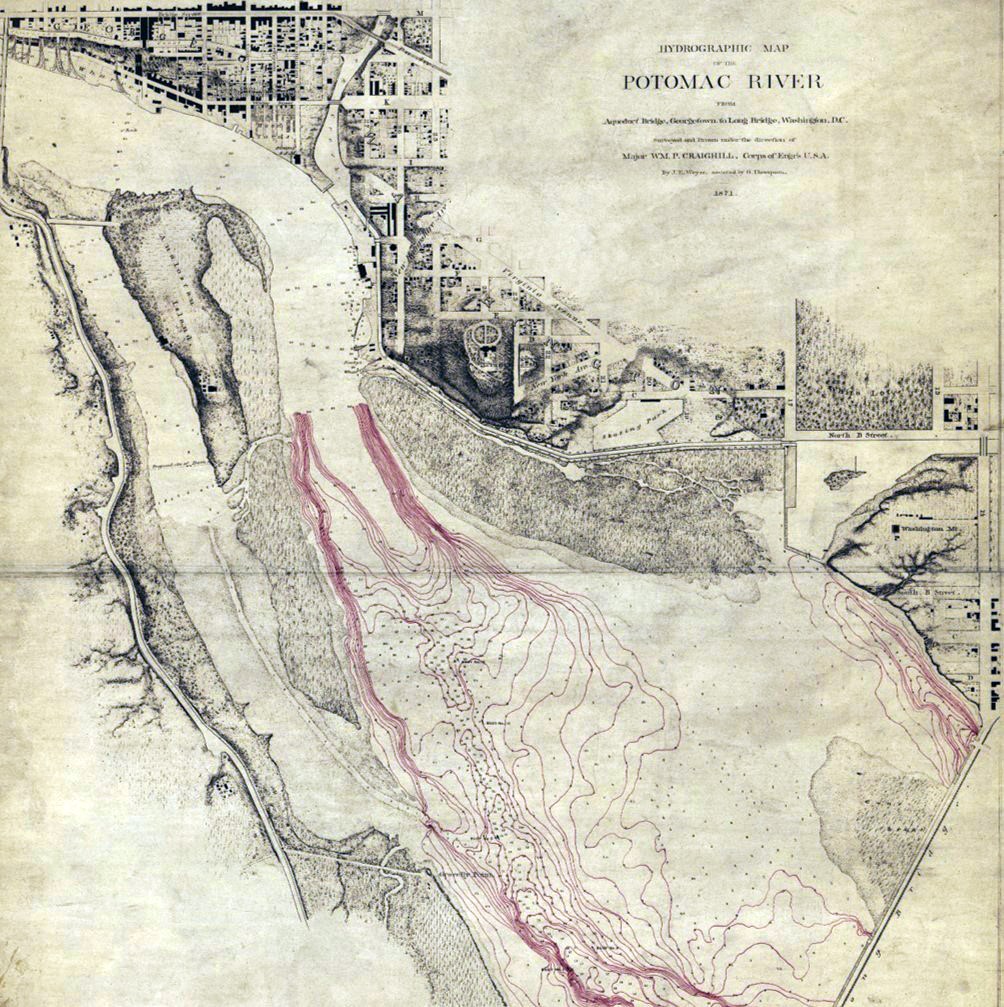Part of a series of articles titled History and Archeology of the District of Columbia Monumental Core.
Article
Flood Abatement and Landmass Creation: Part 2

NPS
Major floods in 1831, 1840, 1856, 1860 and 1867 clogged the shipping channels and formed shoals that were visible at low tide. By 1837 large mud flats were forming on the leeward side of Mason’s Island and below Easby’s Point on the D.C. side, and by 1841 the Washington Channel was completely blocked above 17th Street. The accumulating sediment deposits formed canebrakes (marshland) along the channels. These marshlands grew by self-replicating in which the vegetation trapped new sediments borne by the down steam current.
With responsibility for maintenance of the navigation channels of the Potomac River, Michler developed dredging plans that would create a 200-foot wide channel, 15 feet below mean low tide, between Long Bridge and Georgetown. A key element of Michler’s plan was to use the tidal flats along the channels as disposal sites for the dredged material, a practice that was followed for the next four decades (Chappell 1973). But it quickly became apparent that material that had been dredged and deposited on the tidal flats was often washed back into the navigation channel. The flood of 1877 emphasized this point, dumping 6 feet of sediment in the channel, undoing years’ of channel maintenance work. As a result, later channel dredging plans included a system of retaining walls to hold the dredged material in place.
Responsibility for the Potomac Flats reclamation project was assigned to Major Peter C. Hains in August 1882. Hains would be remembered for the massive program of land reclamation along the Potomac and Anacostia Rivers that was completed in the final decades of the 19th century. Hains divided the dredging work between Giesboro Point and Easby’s Point (roughly at 23rd Street, NW) into three sections. Section I, between Easby’s Point and 17th Street, an area now encompassed by West Potomac Park, was considered the most troublesome area and was the first to be reclaimed. The massive quantities of dredged material required an elaborate system of dredging machines, locomotives, railcars, scows, water pumps, and an elevated railway system that would move the spoil to the disposal location (Chappell 1973).
“A grave error in sewage disposal was committed when the old canal that ran along B Street was converted into a sewer, with its discharge onto the flats at the foot of 17th Street. The greater part of the flats being covered at about half tide, the sewage spread out on them, and, when the tide went out, left it in putrid masses, exposed to the direct rays of the sun.” (Hains 1894)
Under Hains’ supervision, reclamation of the flats continued at a rapid pace through the 1880s. The flood of 1889 then set a new record as the highest in recorded history. The C&O Canal was ruined, and more than one million cubic yards of silt filled the recently dredged channels, setting the work back by two years. By 1890 a total of 8,301,000 cubic yards material had been redeposited, slightly more than two-thirds of the amount Hains estimated was required to reclaim the 621 acres of new land. Work in an area of Section I known as Kidwell’s Meadows was delayed because of litigation. leaving the ultimate use of the reclaimed lands an open question. After a nine-year legal struggle, the Supreme Court ruled in 1895 that the title to the reclaimed land rested with the United States. Congress then declared that the land would become public parkland, snubbing the interests of railroads, industries, and real estate developers. A lingering legal issue known as the “Potomac Flats Case” was resolved in 1898, removing the last obstacle to the redevelopment of Section I. The filling of Section I was completed in September 1901; during the final month of work, a record total of 177,000 cubic yards of material was deposited in 28 days. With that, 31 acres of reclaimed land adjacent to the Washington Monument was turned over to the OPB&G for development as parkland (Chappell 1973).
While lacking the glamour and profile of the Eiffel Tower or the Brooklyn Bridge, the reclamation of Potomac Flats stands as a major engineering achievement of the late 19th century. New technologies were developed that allowed the reshaping of a modern urban landscape on a scale that had not been seen before. The engineering was advanced enough to merit publication in Scientific American (Scientific American 1891).
References
Chappell, Gordon. 1973. Historic Resource Study, West Potomac Park: A History. National Park Service, Denver Service Center, Denver, Colorado.
Hains, Peter C. 1894. Reclamation of the Potomac Flats at Washington, D.C. Transactions of the American Society of Civil Engineers 31: 55-80.
Last updated: April 17, 2020
